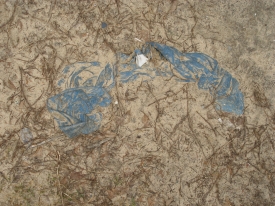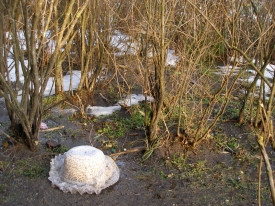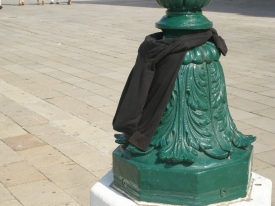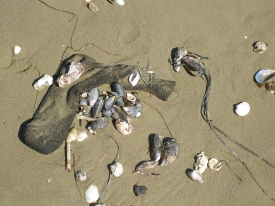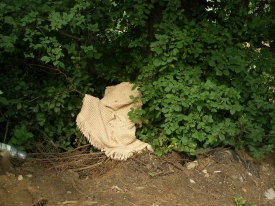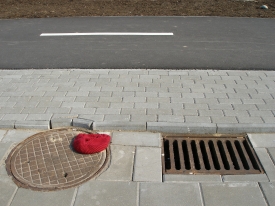MARZANNA MOROZEWICZ – Still lifes
Still lifes
The “Reality” of Found Objects
Marzanna Morozewicz photographs gloves found on the street, tights lying on the grass, lost sweaters, blouses, socks, hats, scarves and other abandoned or lost articles of clothing. At first it seems to be quite a boring activity and rather infertile in the cognitive sense. Other kinds of dumped objects that are usually considered much more interesting include old, rust-eaten and bent washing machines or refrigerators lounging “picturesquely” in suburban woods, “blind” television sets, disemboweled sofas, tattered car seats, etc. Although on the surface they carry a greater dose of dramatic tension than a banal glove, blouse or tights, Marzanna Morozewicz is not deceived by their obvious and now rather trivialized photogeneity. She is only interested in pieces of clothing, which she treats as stationary traces of their owners – a kind of shed skin. They form the canvas for her own personal form of still lifes.
Found on the street, in the depths of a neighborhood dumpster, on a post in Saint Mark’s Square in Venice, or on a seaside beach, they are usually devoid of any interrelation between their outer layer and their prior inner “filling”. Trampled into the ground, covered with sand, suppressed, battered – they seem to be deprived of their former qualities. Once defined by an emptiness and the body of the human being that filled it, as lost or deserted objects they now reveal their substantive traits in a new way. You can thus conclude, paraphrasing the language of philosophy, that Marzanna Morozewicz with her photography attempts to examine the “substantive” nature of banal objects, by bringing out the specificity of their lost or forgotten “being”. In this way, she seems to strive to find the certainty of “being” and, at the same time, confirmation of her own “being”. These photographed objects, lying peacefully, hanging or knocking about on sidewalks – as forsaken testimonies of “being” – obtrusively provoke us to ask different questions, such as: why did someone hang an old jacket on a tree? How did a woman’s blouse find its way onto a forest path, and why has it been trampled into the sand? Where did the woman’s tights lying on the sun-burnt grass come from?
A human being today communicates mainly through objects, which he produces in particularly large quantities, which is a phenomenon of historic proportions. Advertising specialists often assume that mass-produced items, like people, have their own “personality”. Nobody buys anything by accident, and choices are strongly driven not only by the function of the product but by its aesthetics – its shape, color and the nature of the materials from which it is produced. It is noticeable that the consumer often subconsciously creates a sort of aesthetic biotope, in which the things he buys falls into a cohesive, in the aesthetic sense, system. Objects thus speak about their owners – this applies mainly to clothing, which is an obvious tool for communication in the social sense, constituting one of the tools for building one’s identity. The garments found by Marzanna Morozewicz, once identified, usually tell us about their owners: their gender, age, material status, aesthetic tastes, and sometimes their manners – for instance, how they like to spend their free time – but also often about their absent-mindedness, negligence, or just plain bad luck. Sometimes the objects encountered make us worry or think about particularly dramatic events. The author’s artistic photographs, which seem to manifest a very clear view of “reality”, reveal many emotions in the experience of the world surrounding her.
Is this really only about abandoned or lost objects acting as testimonies to “being”? For example, a striking feature of this seemingly documentary photography is a composition that has been very carefully thought through, which in this type of photography is not always of paramount importance. Apart from the refined composition, our attention is also drawn to the careful selection of colors. Even though they were “found” – on a sidewalk or on a seaside beach, where the texture and warmth of the pale color of the sand remains in tension with the “foreign” texture and color of the forgotten sock or scarf, the colors usually form a united and logical structure, perceived here in painterly terms. Bearing this in mind, we can see the photographs of Marzanna Morozewicz as an example of a fascination with the modernist concept of painting. In this case, it is realized using digital photography. The author, however, never interferes with her “documents”, does not use computer software (common nowadays) to process the effects of her work. Hence, nothing in her artistic photographs is beautified, everything, let’s repeat this, was “found” “existing”. At the same time when the photographs were blown-up for the exhibition, they revealed a painterly power. Documentary photographs turned out to be “realistic” paintings. Photographic technique lends credence to their “realism”, and they seem to be a representation of “reality”, since photography undoubtedly registers reality. However, the problem here is that nobody can be absolutely certain what “reality” is or could be, and therefore, it would be safer to treat the photographic paintings of Marzanna Morozewicz as a kind of touching of “reality” rather than depicting it, in the commonly understood meaning of that word. The only thing we can be certain about is that in documenting banal articles of clothing, the author uses them mainly to compose images with a stricte painterly potential, saturated with an extremely powerful emotional load. Considering their dramatic tension, you can also observe that, in fact, these are figurative paintings.
MARZANNA MARIA MOROZEWICZ
Born on April 21st, 1965 in Bialystok, Poland
1984-1989 Studies at the Institute of Artistic Education,
Maria Curie-Sklodowska University in Lublin;
1998 Doctorate at Painting, Academy of Fine Arts in Warsaw;
2000 Postgraduate studies in Art Therapy, Polish Erickson Institute in Lodz;
2007 Higher doctorate at the Faculty of Painting, Academy of Fine Arts in Warsaw;
2008 Extraordinary Professor at the Faculty of Pedagogy and Psychology, University in Bialystok;
Art activities in the area of painting (paintings, painting objects), tapestry, drawing and photography
www.mamo.art.pl
Selected solo exhibitions:
PAINTINGS, Arsenal Gallery, Bialystok 1995 [catalogue]
TWO FORMS, Biała Gallery, Lublin 1996 [catalogue]
OPENING – INFILTRATION, Nad Wisłą Gallery, Torun 1997 [catalogue]
CLOSENESSES, Biala Gallery, Lublin 1998 [catalogue]
SCALES, XXI Gallery, Warsaw 2001 [catalogue]
MM, Arsenal Gallery, Bialystok 2002 [catalogue]
ROSARIUM, Biała Gallery, Lublin 2004 [catalogue]
OH, HOW FEMININE IT IS, Wozownia Gallery, Torun, 2006
EXPERIENCE OF FEMINITY, Aspekt Gallery, ASP Warsaw 2007
STILL LIFES, Arsenal Gallery, Bialystok 2008 [catalogue]
Selected group exhibitions:
WITH ART – TOWARDS ART, Centre of Polish Sculpture, Oronsko 1997 [catalogue]
WHITE, Arsenal Gallery, Bialystok 2000 [catalogue] BIENNALE OF CONTEMPORARY PAINTING BIELSKA AUTUMN, BWA Bielska Gallery, Bielsko-Biala 2003 [catalogue]
NOVA WHITE, Biala Gallery, Lublin 2005 [catalogue] MERRY CHRISTMAS, Arsenal Gallery, Bialystok 2005/2006 [catalogue]
CONDITIONS – REALITY, SENSUALITY, CORPOREALITY, Polish Institute, Düsseldorf(Germany) 2006
FORBIDDEN GAMES, Polish Institute, Paris 2006 [catalogue]
POLISH PAINTING of the XXI CENTURY, Zachęta National Art Gallery, Warsaw 2006/2007 [catalogue] WOMAN BY WOMAN, BWA Bielska Gallery, Bielsko-Biala 2007
P-Art . Polish Gegenwartskunst , Münsterlandfestival pART 4, Open Art Gallery, Borken (Germany) 2008 (in cooperation with Polish Institute in Düsseldorf)
Marzanna Morozewicz
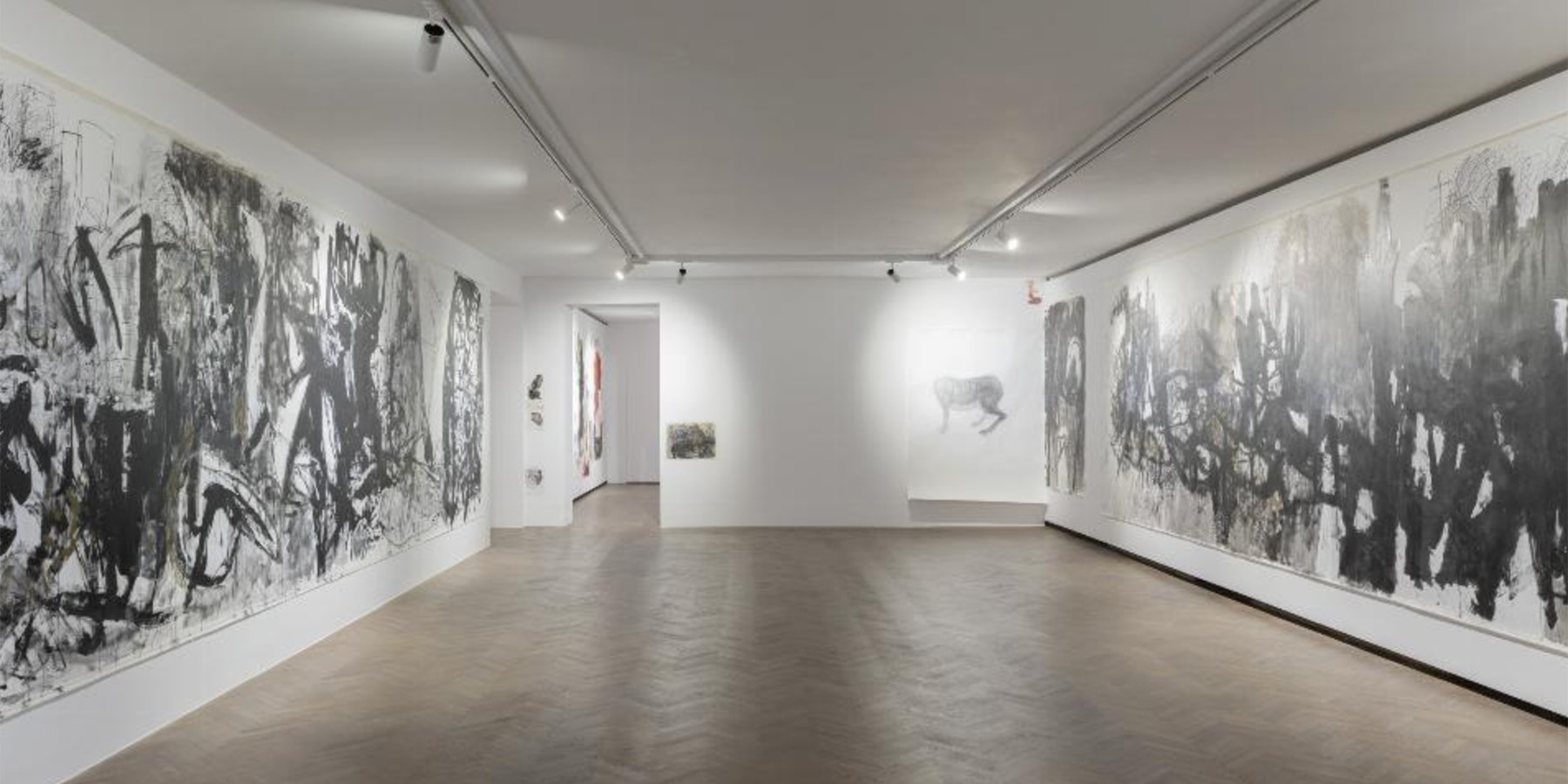
PLAN YOUR VISIT
Opening times:
Thuesday – Sunday
10:00-18:00
Last admission
to exhibition is at:
17.30
